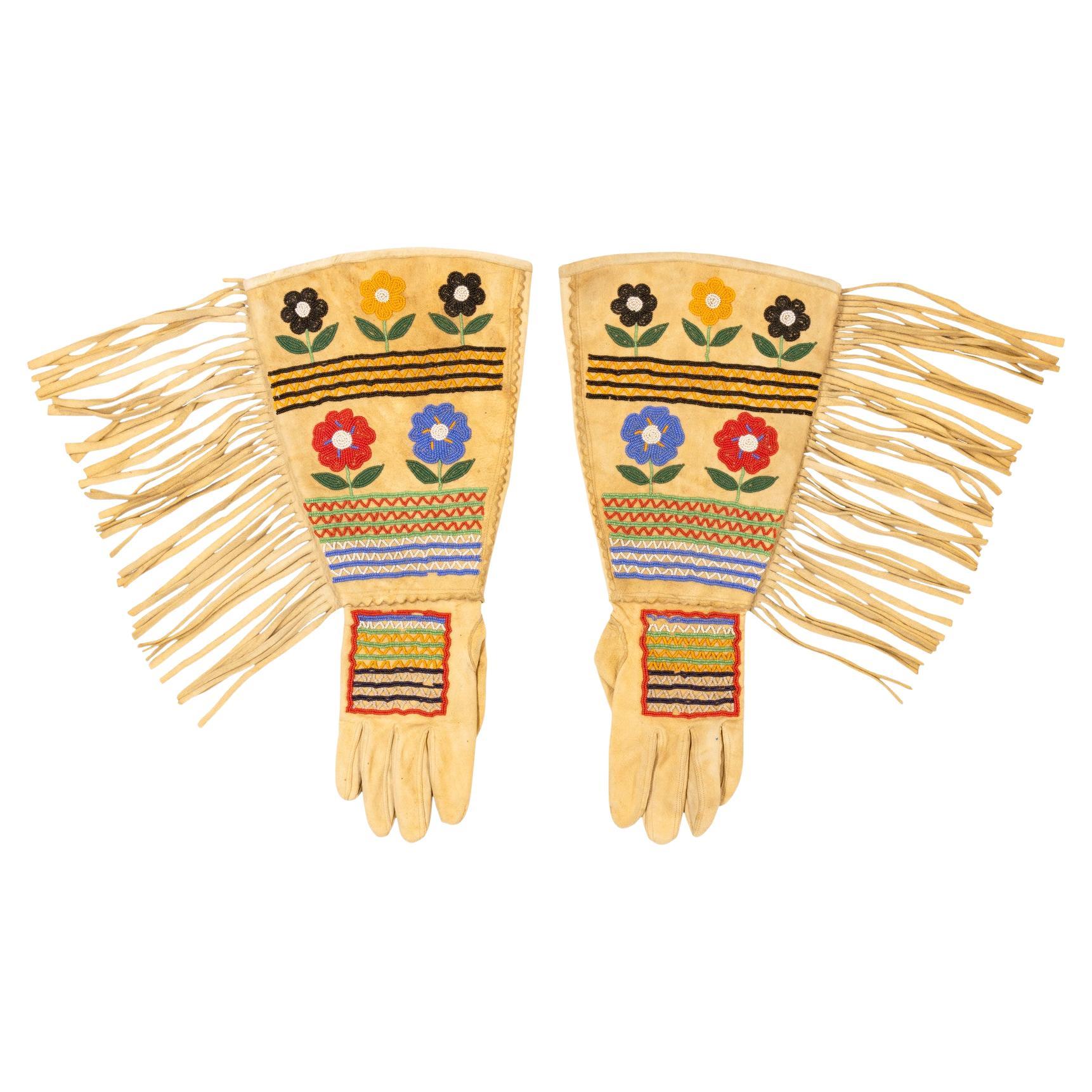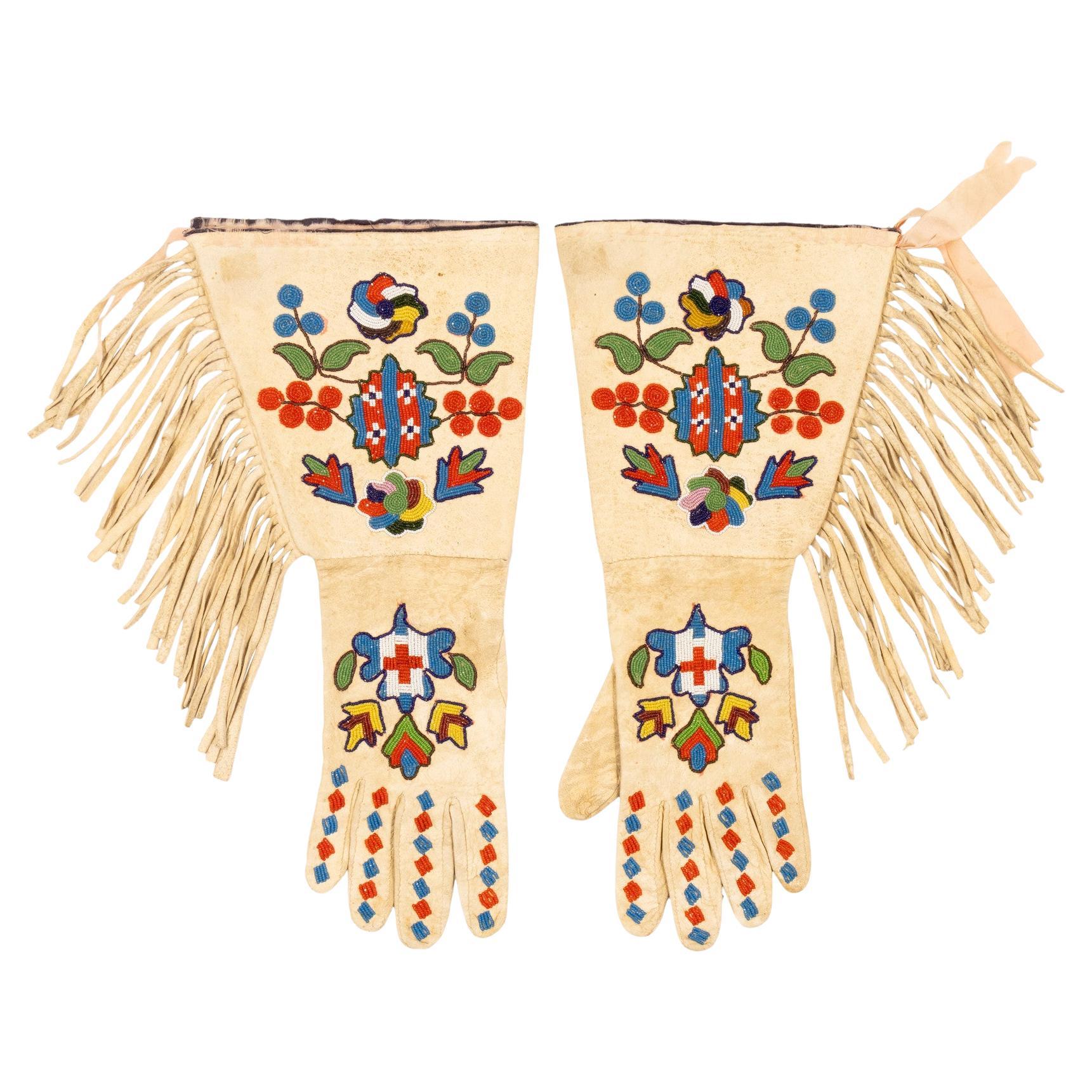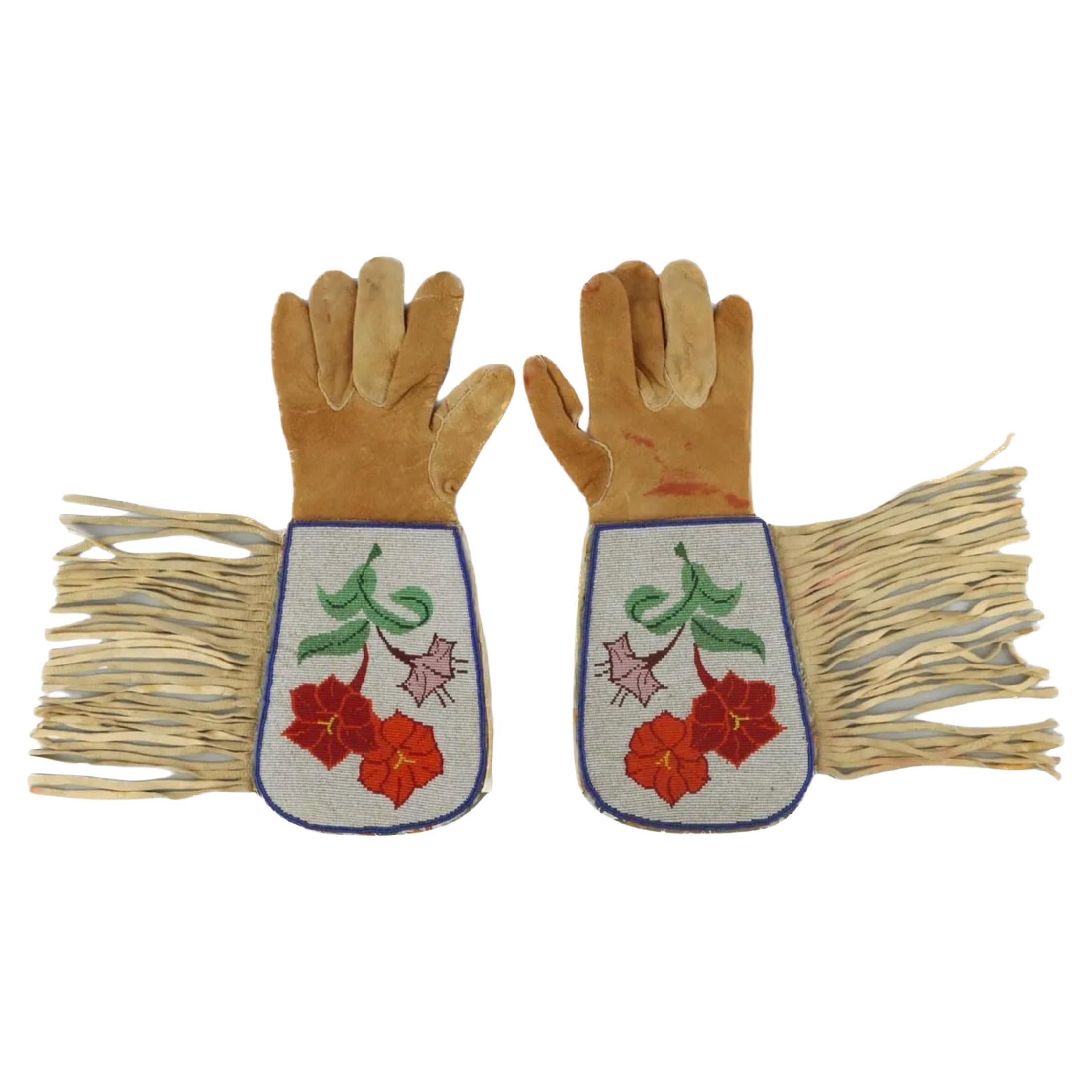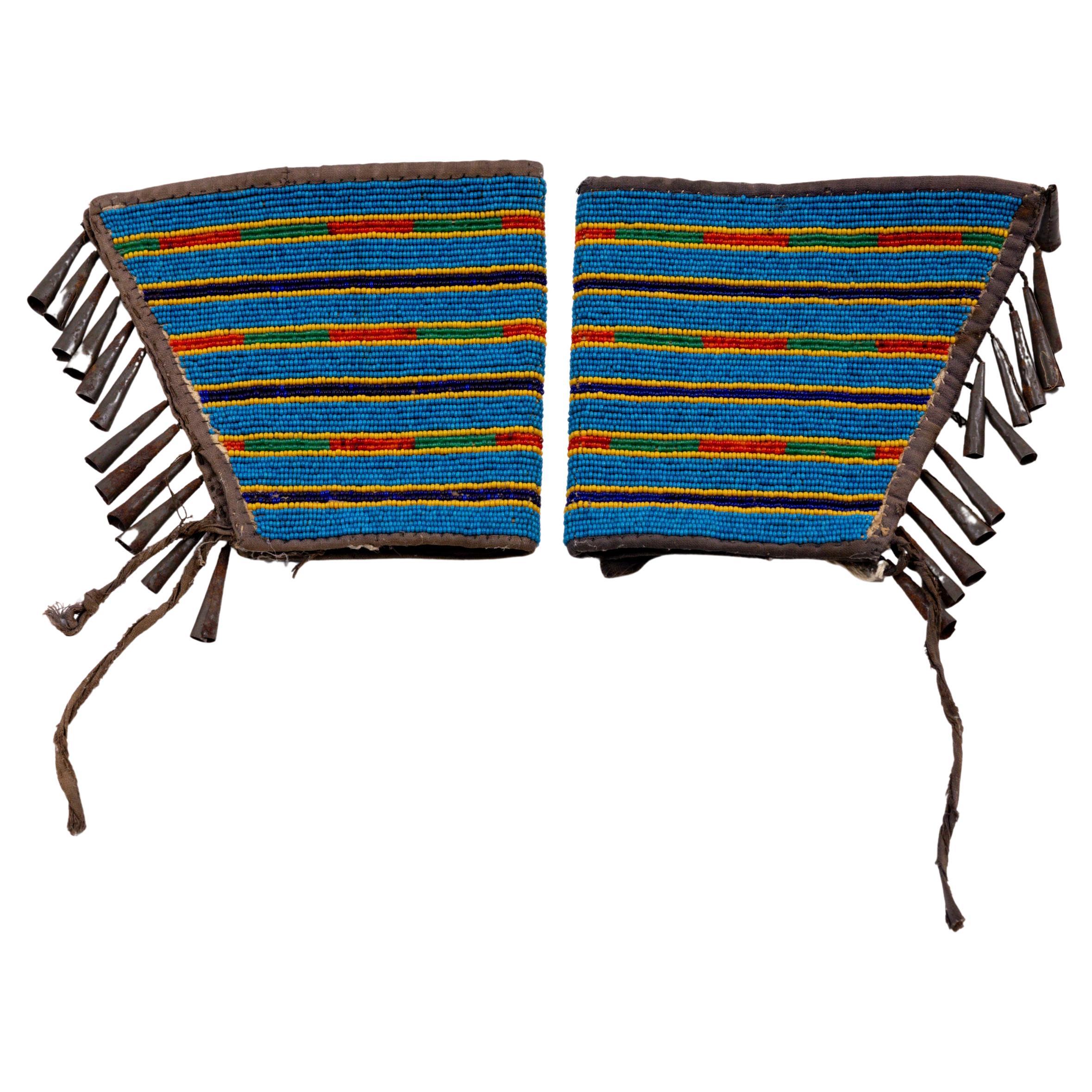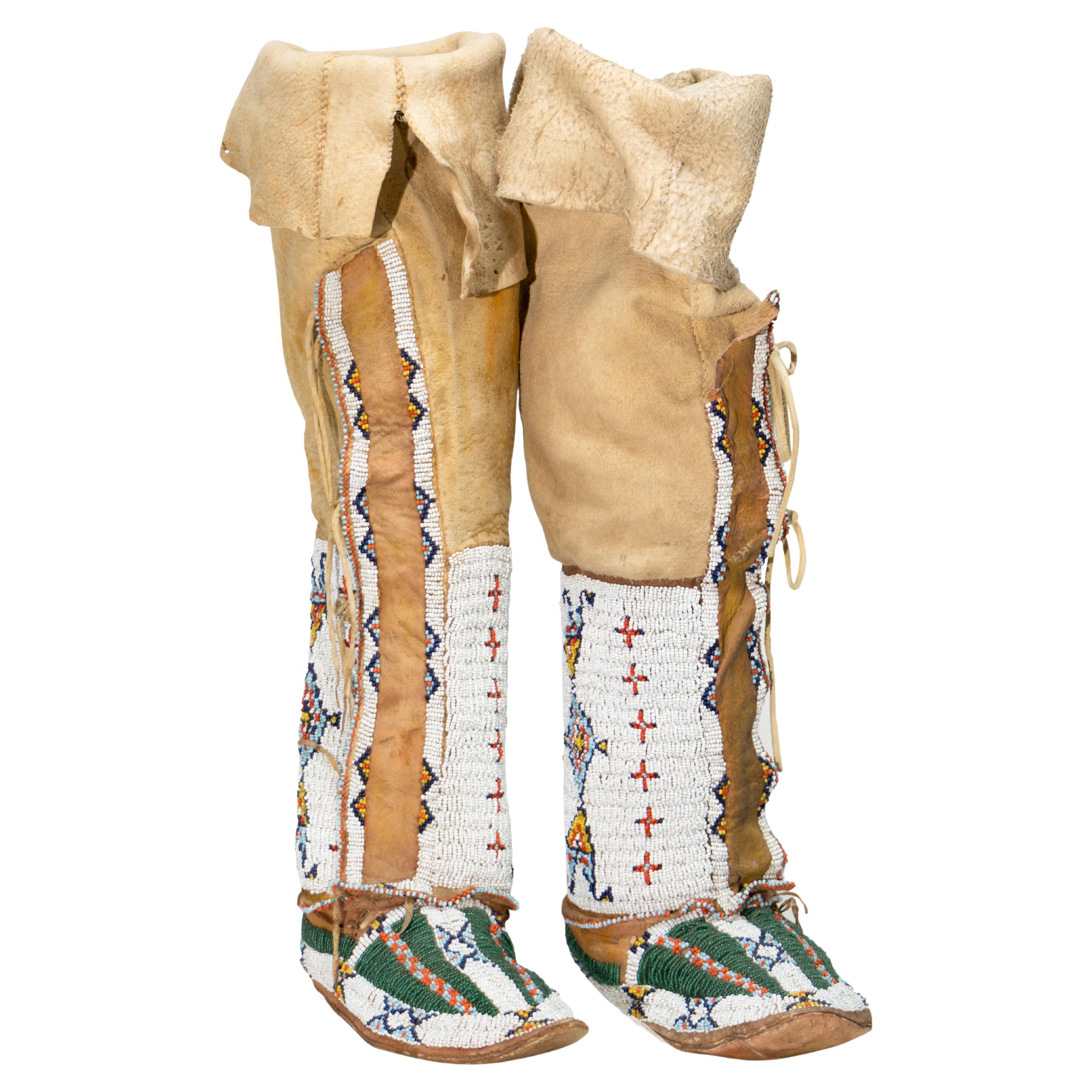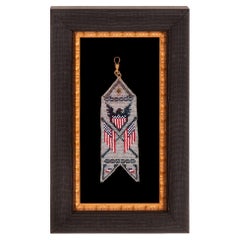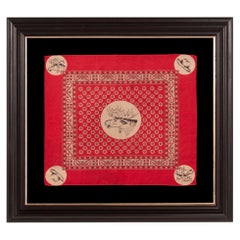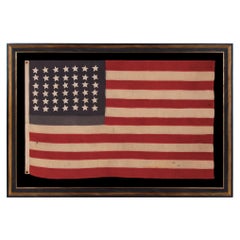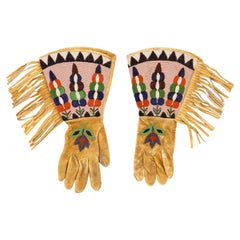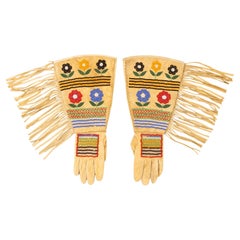Items Similar to Native American Beadwork Gauntlets with an Chief, ca 1880-90
Want more images or videos?
Request additional images or videos from the seller
1 of 6
Native American Beadwork Gauntlets with an Chief, ca 1880-90
$6,500
£4,936.91
€5,703.76
CA$9,109.98
A$10,195.79
CHF 5,321.42
MX$124,336.04
NOK 68,106.89
SEK 64,471.90
DKK 42,566.42
Shipping
Retrieving quote...The 1stDibs Promise:
Authenticity Guarantee,
Money-Back Guarantee,
24-Hour Cancellation
About the Item
Native American beadwork gauntlets with Indian Chiefs in feathered headdresses, probably souix, Ca 1880-90
Native American beadwork gauntlets with beautiful graphics and endearing wear. Made of doeskin, the imagery includes colorfully dressed Indian chiefs, in feathered headdresses, facing one-another. Made circa 1880-1890, many of these types of gauntlets were sold to soldiers and were popular during the Indian Wars (1866-1890) and the Spanish-American War (1898) era. Most likely these particular examples saw use in wild west shows, which were immensely popular at the time.
Mounting: The antique, solid walnut molding has a press-decorated edge, retains its original, black, varnished surface and gilded liner, and dates to the period between 1860 and 1880. The gauntlets have been hand-stitched to 100% hemp fabric. Spacers keep the textiles away from the glass, which is U.V. protective.
Condition: Significant soiling and moderate to significant wear from obvious use.
- Dimensions:Height: 20.25 in (51.44 cm)Width: 26.5 in (67.31 cm)Depth: 2 in (5.08 cm)
- Materials and Techniques:
- Place of Origin:
- Period:
- Date of Manufacture:1880-1890
- Condition:See Item Description.
- Seller Location:York County, PA
- Reference Number:Seller: otx-0211stDibs: LU849725640882
About the Seller
5.0
Recognized Seller
These prestigious sellers are industry leaders and represent the highest echelon for item quality and design.
Established in 1991
1stDibs seller since 2008
70 sales on 1stDibs
Typical response time: Several days
- ShippingRetrieving quote...Shipping from: York County, PA
- Return Policy
Authenticity Guarantee
In the unlikely event there’s an issue with an item’s authenticity, contact us within 1 year for a full refund. DetailsMoney-Back Guarantee
If your item is not as described, is damaged in transit, or does not arrive, contact us within 7 days for a full refund. Details24-Hour Cancellation
You have a 24-hour grace period in which to reconsider your purchase, with no questions asked.Vetted Professional Sellers
Our world-class sellers must adhere to strict standards for service and quality, maintaining the integrity of our listings.Price-Match Guarantee
If you find that a seller listed the same item for a lower price elsewhere, we’ll match it.Trusted Global Delivery
Our best-in-class carrier network provides specialized shipping options worldwide, including custom delivery.More From This Seller
View AllNative American Beaded Watch Fob with Crossed Flags, ca 1915-1920
Located in York County, PA
NATIVE AMERICAN BEADED WATCH FOB WITH A STYLIZED FEDERAL EAGLE & SHIELD AND CROSSED AMERICAN FLAGS, circa 1915-1920’s
Native American beaded pocket w...
Category
Vintage 1910s American Political and Patriotic Memorabilia
Materials
Beads
Cast Iron Boot Jack Made for 1864 Presidential Campaign of George McClellan
Located in York County, PA
CAST IRON BOOT JACK, MADE FOR THE 1864 PRESIDENTIAL CAMPAIGN OF GENERAL GEORGE B. MC CLELLAN, WITH A FANTASTIC SLOGAN THAT READS "THE UNION AT ALL HAZZARDS"
Made for the 1864 presidential run of George B. McClellan, this cast iron bootjack is both rare and graphically exceptional. Displaying the original black-painted surface, with attractive and desirable patina, the stylized profile has a wonderful folk art quality. Molded block letters that wrap around the heel clasp read simply "Gen. Mc Clellan. These are accompanied by a prominent Civil War-associated slogan: "The Union at all Hazards." The text is intermingled with 34 stars, which was equivalent to the number of states during the opening two years of the war, but was one star short by mid-1863 and two stars short by the time of the actual election in 1864. It's not unusual to encounter this feature in civil war campaign parade flags as well as all manner of flag-related ephemera.
The iron was reportedly cast by G. & D. Cross of Morrisville, New York, though it is unsigned and I have not yet verified the attribution. I have seen two other examples, one of which had a broken and repaired tine on the U-shaped horns and newly painted surface, while the other appeared to have broken lifters and inferior, rusted patina. This is, hands-down, the best of the identified examples.
Brief History of the 1864 Campaign:
President Abraham Lincoln had a checkered relationship with his 1864 opponent, who he had formerly chosen as General-in-Chief of the entire Union Army. The career officer repeatedly knocked heads with his Commander-in-Chief. Having raised a well-trained and organized military force, McClellan often seemed reluctant to use it. By 1862, after losses in Virginia during the Peninsula Campaign, Lincoln grew frustrated with McClellan and the progression of the war and removed him from command.
By the early part of 1864 the American people shared some of the same frustrations and Lincoln was no longer the clear choice for the White House. The nation was tired of war and the remains of the Democratic Party...
Category
Antique 1860s American Political and Patriotic Memorabilia
Materials
Iron
Teddy Roosevelt Silk Kerchief Made for His 1912 Presidential Run
Located in York County, PA
SILK CAMPAIGN KERCHIEF FEATURING A PROMINENT BULL MOOSE, MADE FOR THE 1912 PRESIDENTIAL RUN OF TEDDY ROOSEVELT, WHEN HE RAN ON THE NATIONAL PROGRESSIVE PARTY TICKET
Printed silk ker...
Category
Vintage 1910s American Political and Patriotic Memorabilia
Materials
Silk
Price Upon Request
42 Hand Sewn Stars on An Antique American Flag ca 1889-1890
Located in York County, PA
42 HAND-SEWN STARS ON AN ANTIQUE AMERICAN FLAG WITH A TWO-TONE, DUSTY BLUE CANTON, REFLECTS THE ADDITION OF WASHINGTON STATE, MONTANA, AND THE DAKOTAS, NEVER AN OFFICIAL STAR COUNT, ...
Category
Antique Late 19th Century American Political and Patriotic Memorabilia
Materials
Wool
Price Upon Request
13 Star Woven Silk Ribbon, ca 1876-1910
Located in York County, PA
13 STAR RIBBON, WOVEN SILK, circa 1876-1910
13 star antique American flag ribbon, made of woven silk, of the type encountered in military, political, and fraternal badges and ribbon...
Category
Antique 1870s American Political and Patriotic Memorabilia
Materials
Silk
34 TUMBLING STARS on an ANTIQUE AMERICAN FLAG, CIVIL WAR PERIOD, 1861-63, KANSAS
Located in York County, PA
34 STARS WITH "DANCING" OR "TUMBLING" ORIENTATION, ON AN ANTIQUE AMERICAN FLAG WITH EXTRAORDINARY COLORS, PRESS-DYED ON WOOL BUNTING, LIKELY PRODUCED FOR USE AS MILITARY CAMP COLORS,...
Category
Antique 1860s American Political and Patriotic Memorabilia
Materials
Wool
You May Also Like
Plateau Beaded Gauntlets
By Native American Art
Located in Coeur d'Alene, ID
Native American Plateau floral beaded gauntlets. Design is bold and bright, featuring colors of green, blue and red flowers on a large 7 1/2" x 7 1/2"...
Category
Early 20th Century American Native American Native American Objects
Materials
Leather, Beads
$5,175
Native American Cree Beaded Gauntlets
By Native American Art
Located in Coeur d'Alene, ID
Large pair of Native American beaded Cree gauntlets. Featuring five multicolored flowers and zigzag pattern banding done in colors of red, yellow, black, blue, green, and white. 18" ...
Category
Early 20th Century American Native American Native American Objects
Materials
Leather, Beads
Santee Sioux Gauntlets
By Native American Art
Located in Coeur d'Alene, ID
Native American Santee Sioux beaded gauntlets. Striking colorful gauntlets with fringed sides and classic beading on the cuff, hand and fingers. Desig...
Category
Early 20th Century American Native American Native American Objects
Materials
Hide, Beads
$4,025
Pair of Fully Beaded Gauntlets
Located in Dallas, TX
A pair of beaded gauntlets most likely Plateau, Nez Perce or Yakima. 6 X 8 fully beaded panels. The beads are tight and none are missing. The leath...
Category
Antique 19th Century American Native American Native American Objects
Materials
Leather
Crow Plains Native American Beaded Leather Cuffs, Bar Design, 20th Century
By Native American Art
Located in Denver, CO
Exceptional pair of late 19th-century Northern Plains Native American wrist cuffs, attributed to the Crow (Apsáalooke) people. Also known as gauntlet cuffs, these pieces are crafted ...
Category
Antique Late 19th Century American Native American Native American Objects
Materials
Tin
19th Century, Sioux Beaded High-Top Moccasins
By Sioux Indian Art
Located in Coeur d'Alene, ID
This is an outstanding set of authentic original beaded hide high-top / high-top moccasins with hard parfleche soles from the Sioux Native American Indians dating to circa 1880. The set shows stiff Indian tanned hide moccasins with hard parfleche rawhide soles and the tops being covered in period correct 1800’s glass trade seed beads that are sinew sewn in a traditional Buffalo track geometric pattern. The moccasins have a red ocher mineral pigment paint and are completely sinew rawhide sewn. The moccasins have sewn on high top / high-top leggings done in Indian tanned hide which is very stiff and has a sewn-on section at the top of Indian tanned Buffalo Bison hide...
Category
Antique Late 19th Century American Native American Native American Objects
Materials
Hide, Beads
More Ways To Browse
American Walnut Furniture
American 19th Century Antiques
American West Furniture
1880 Fabric
Antique American Textiles
American West Antiques
Indian Chiefs
Feather Headdress
Antique Beadwork
Antique Indian Chief
Antique Hemp
Folk Art Soldier
Antique Native American Beadwork
American Indian Dress
Antique Indian Beadwork
Native American Gauntlets
Navajo Saddle Blankets
Native American Northwest

